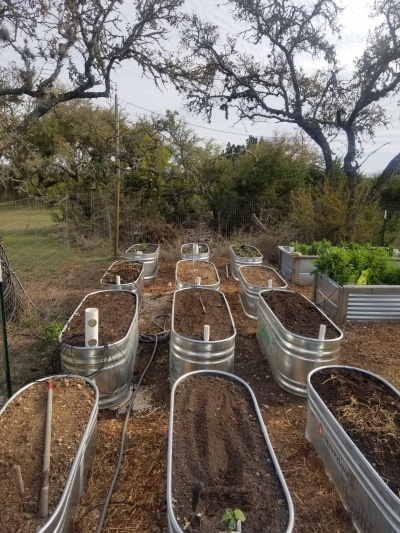It is now spring and the level of effort now has increased three fold. Eighteen wicking boxes have been built and twelve of them have been planted with the others waiting for the seedlings to come out from under the grow lights. This is the first year that I started all of the seedlings under the grow light and I am impressed with the success of the endeavor. The vine vegetables have been so successful so far that the trellis’ for the cucumbers, bitter melons, and watermelons had to be built ahead of schedule.
This success can be contributed from five years of experimenting with raised beds and finding the faults of the raised beds in the Texas Hill Country. First of all why raised beds? It all comes down to the terrain that the homestead is on. The Texas Hill County is made up of the Edwards Plateau which consists of limestone and granite. The limestone was formed during the Cretaceous period when the region was part of the Great Inland Sea. However there is rock and formations that I have found that range from the Jurassic to the Quatemary when the last remnants of the ice age melted into the aquafer.
With all of this limestone it is difficult to farm in a more traditional manner since limestone can be found from the surface to the 18” deep and everything in between. With no consistent depth of soil boxes were the most economical and practical option. The first boxes were raised beds made from wood that had the dimensions of 4’ wide, 2’ tall, and 8’ long. There were four of these boxes that were built. The fault of this style of box in the Hill Country is that watering leads to soil compaction very quickly. Another issue was water. There was never enough water that was placed on the box to get anything to thrive.
This is where wicking boxes came into play. The first generation wicking box that I built was of the same dimensions as the raised beds, but with the addition of a plastic lining on the bottom to hold in the water. Crushed rock is placed on the bottom of these boxes to form a reservoir. The soil is placed on top of that so that the soil acts as a wick sucking up the water from the reservoir. This design worked well for two years but had to be rebuilt because of the wood decaying. The third generation was to take metal roofing screwed into wood so that the metal is in contact with the plastic lining. The major fault of these boxes was that the plastic, which was 6 mill, was not thick enough to prevent punctures therefor the reservoir leaked out over a short time.

The current model of wicking boxes is a 2’ tall, 2’ wide, and 6’ long. A 1.5” PVC pipe is run on the bottom, perforated, and 90 degree joint attaches the 2’ pipe out of the container. Just like before rock fills the first 12” of the box and the soil is placed on top. The pipe is to fill the reservoir when needed and since the stock tank is steel there is no worries of perforating plastic. With the whole piping system there is little concern for soil compaction since the water is going directly into the reservoir via the PVC pipe.
The soil was mixed with composted chicken poop and other organic fertilizer.
